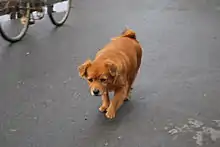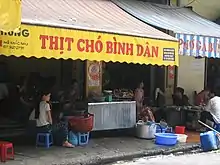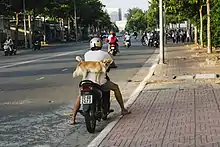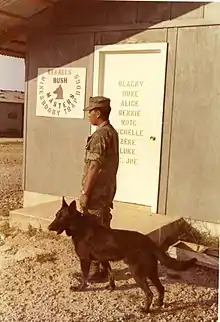.jpg.webp)
Dog meat (Vietnamese: thịt chó) consumption can be found in Vietnam, similar to other Asian countries such as South Korea, Laos, and China.
According to the Four Paws February 2020 report on the dog and cat meat trade in Southeast Asian countries, roughly 5 million dogs are killed for their meat each year in Vietnam.[1] Although the report indicated that Vietnam is the second biggest consumer of dog meat,[2] this practice is only common among a minority of the population.[1]
Debate over dog meat consumption in Vietnam has become more frequent. This increased debate has been impacted by animal activists in and out of the country, health regulators, the government, globalization and expanding market development.
Part of the dispute may be illustrated as a clash of values due to globalization. Dog meat consumption is regarded as a taboo in the West, and such belief is deeply associated with human-animal relations because dogs are often treated as family members by humans.[3]
Early history
There are relatively few records about the early domestication of dogs in Vietnam. Evidence of dog domestication has been found at the Neolithic settlement of An Son that may be traced back to 2100 BC.[4] The site is located close to the northern border of Long An province in the southern part of the country. It is suggested that the early inhabitants maintained domestic dogs and pigs at the site. In northern Vietnam, a few domestic dog remains were found at the Man Bac site.[4] Similar to pig domestication, butcher marks were observed on the abundance of dog remains at the site, indicating that dogs were a source of food for the inhabitants. More dog remains than pig remains were found at the site. There was no evidence of special treatment of dogs such as burial that would indicate human-dog emotional ties.[4]
Cultural beliefs
Spiritual worship
Cultural beliefs about dogs are usually connected to the role that dogs play in the household and the emotional connections between dogs and humans. Cultural beliefs also shape the tradition of consuming dog meat.
Dogs are generally used as household guardians, but they are treated with little respect.[5] The early nineteenth-century poem "The Quarrel of the Six Beasts" gives a glimpse of the dog's household position through its food. In the poem, the animals are arguing about which animal is most useful by comparing their jobs and the food they eat. The dog in the story claims that it sometimes gets "crumbs of rice and dregs of soup" from the master, but often eats low-quality food such as "rotten taro and wormy yam."[6] In fact, in Intage Vietnam's report about pet care, 9% of the population fed their dogs with leftovers in 2019.[7]
The guard role of dogs transitioned into the worshiping of them. Vietnamese folk culture holds that placing stone dogs in front of temples and houses will drive away ghosts and devils. For example, in Hanoi, dogs were worshiped at the Puppy Temple by Truc Bach lake that may date back to 1010.[8]
The worship of dogs has also been popular among ethnic minorities. The Tay people would counterbalance the bad feng shui in a house by placing a stone dog in the front yard. It is believed that dog sculptures process blessings. The stone dogs are also connected to the sacred creature nghê, a lion dog. The Dao people believe that they are the descendants of the dog god, Panhu. This makes dog meat forbidden in their culture.[6]
For other Vietnamese populations, the sacred power of dogs makes dog meat a special dish on particular occasions. Eating dog meat after a bad event is said to dispel bad luck and contribute to longevity.[9] The dish became a custom in funerals, death anniversaries, and weddings. Dogs were also sacrificed in rituals in the north in order to worship ancestors or to induce rain. Beyond special occasions, dog meat is usually consumed at the end of a lunar month or lunar year. Eating it at the wrong time is believed to instead bring misfortune.[10] This might be associated with the Vietnamese folktale that a dog with white fur and a blood red nose is the embodiment of a demon. The demon is said to return to its original shape during the full moon, which is in the middle of a lunar month.[11]
Masculinity
Dog meat is linked to Vietnamese masculinity by its perceived medicinal ability to improve sexual performance. The linkage is also seen in the spaces where dog meat is consumed. Day to day consumption of dog meat in Hoi An, in central Vietnam, usually occurs in local liquor shops, or quán nhậu. Some of the shops have upgraded to "garden" restaurants. While the quán nhậu are exclusive to male customers, the "garden" restaurants also attract a majority of male customers. Their masculine spaces are where men recharge and boost their masculinity and display and perform it with the female staff who provide sexual services.[10]

This connection can also be analyzed in the framework of Confucianism. The Chinese philosophy has profound influence in defining the proper gender roles in Vietnam, in which males go out and socialize at dog meat restaurants while women are considered inferior and remain at home. Additionally, dog-consuming practices can be seen in many East Asian nations which have been influenced by Confucianism. Dog meat was also called "Confucius meat" because Confucius enjoyed eating it.[10] Beyond Vietnam, in South Korea, people tried to escape from the social pressure of Confucian morals by consuming dog meat.[12]
Political affiliation
According to Confucian values, an ideal man should be educated, knowledgeable and politically involved. This is how dog eating, a popular practice in Confucian society, converged with political engagement. The dog meat tradition persisted as a way of participation or rejection of the dominant political ideology. Through interviews with the Vietnamese it was explained that as many of the new middle class benefited from contact with the ruling elite and the government, they were "obligated to express loyalty and commitment" toward the northern regime through accepting a new culinary practice from the north and rejecting the local moral standards. This is closely related to the Confucian ideas of obedience and loyalty in the social hierarchy.[10]
This transformative culinary practice is not always welcomed without doubts. While Vietnamese enjoy dog meat dishes, they are acutely aware of the problems associated with violence, crime, drunkenness, and illicit sex which make the practices immoral and shameful among the Vietnamese community. Furthermore, showing loyalty by incorporating the dining practice of the northern regime does not indicate that the middle class fully supported the regime.[10]
Modern trends
Increased appetite for wild meat
After recovering from the 1997 Asian financial crisis, the Vietnamese economy returned to rapid growth by 2004, with the continued influx of foreign direct investment.

The appetite for dog and exotic meat increased together with the expansion of general meat consumption. This trend corresponded with the rising popularity of dog meat restaurants in Hoi An. First, the number of dog meat restaurants increased. In 1999, only a couple of places served dog meat, but by 2004 there were "dozens of eating venues throughout the town." Second, the visibility of those restaurants increased. In 1999, it was mentioned that dog meat restaurants were "in [a] maze of alleys" or "outside the town." In addition, instead of writing "Thịt Chó" on the signs, a more obscure expression "Thịt Cầy" (lit. 'civet meat') was used. In 2004, more restaurants were visible with the name "Thịt Chó".[10]
There is an interconnection between dog meat consumption and wild meat consumption, both viewed as exotic. The increase in demand for wild meat is also tied to market development and the bonds of business partnerships.[13] While rich people may show their high social status by serving expensive types of wild meat, others serve expensive wild meat to guests as a way of showing respect for business cooperation. This form of "diplomacy" then leads to the likelihood of success in the partnership. In this way, wild meat consumption constitutes a social norm connected to business culture and partnerships.[13]
A similar type of social protocol of showing respect is seen in South Korean dog meat consumption, in which one tries to impress and show respect for a prestigious guest by offering the meat of one's own pet dog.[12]
Expanding pet market

Counter to the argument that capitalist development led to an increase in demand for dog meat, it is shown that capitalism also brought in the demand for dogs not as a source of food but as a source of companionship.
In the book chapter "An Appetite for Dogs: Consuming and Loving Them in Vietnam" Anthony Podberscek, a scientist for animal behavior and human-animal interaction in Australia, claims that capitalist development also brought about changes in dog-eating traditions.[14]
The first commercial pet shop opened in Ho Chi Minh City in 2006, and within 8 years, pet shops expanded in number and availability in different cities.[15] Furthermore, luxurious grooming services have been offered to pet owners in cities.
Vietnamese pet retailers often run a cash-based business which makes analysis of the industry harder. Although little scholarly analysis has focused on the potential influence of the expanding pet care industry on dog consumption, there is enough evidence to indicate that the pet care market is on the rise.[15]
This change might be brought on by the increasingly important concept of companion animals. An interview conducted with a clinic owner in Vietnam shows pet owners' increased willingness to spend more money on their pets.[16]
Capitalist development is giving people more economic capacity and may also lead to an increase in their interaction with pets, strengthening human-animal relations. Statistics provided by Podberscek suggest that some part of the population in the south are supportive toward a ban on the consumption of dog meat.[14] The practice of refusing to eat dog meat as a pet owner is also frequently observed.
Legal status

Vietnamese pet owners together with activists from other nations are advocating for banning the sale and trade of dog meat. As of 2023, the Soi Dog Foundation is collecting 1.5 million signatures to submit a petition to ban dog meat to the Communist Party of Vietnam. In the petition, China's progress on forbidding the trade of cat, dog and wildlife meat is mentioned. Besides emotional appeals, public health concerns over diseases and the nation's image as a civilized and modern nation are highlighted.[17]
In French Indochina, the slaughtering and eating of dogs was banned in the late 19th century. However, dog meat began to be consumed again after the French left.[9]
Legislation provides pet owners some protection over pet theft. In July 2016, a law was amended to enable prosecutions against thieves whose crimes cause social disorder.[1] The amendment meant that the theft of even a single dog could result in a jail sentence. Previously, criminals had stolen dogs from homes with near immunity as the dogs were considered to have too little financial value to prosecute over.
More recently, in 2018, a statement was issued by the director of the Hanoi Department of Animal Health stating that raising public awareness of the risks of dog meat consumption needed to be strengthened to discourage the practice, and that the dog meat trade would be eliminated from the city's central 21 districts by 2021. In 2019, the Food Safety Management Board in Ho Chi Minh City urged people to stop consuming dog meat. However, there was no law issued to ban the dog meat trade.[1]
Controversy and debate
The consumption of dog meat and exotic meat has been condemned by the West as being "backward" and archaic.[18] Animal rights have become an increasingly important parameter in assessing a nation's development and progress. NGOs such as Four Paws have promoted that globalized developments such as transnational tourism have created pressure for a shift in the tradition of Vietnam.[1] There is also hope that Asians who received a Western education will foster changes in Vietnam.[19]
See also
References
- 1 2 3 4 5 "The Dog and Cat Meat Trade in Southeast Asia: A Threat to Animals and People" (PDF). Four Paws. Archived (PDF) from the original on 2020-04-23.
- ↑ VnExpress. "Vietnam kills at least 5 million dogs a year, mostly in brutal ways - VnExpress International". VnExpress International – Latest news, business, travel and analysis from Vietnam. Retrieved 2021-04-10.
- ↑ "Eat, Prey, Love: Vietnam's dogs double as family members and dinner". The World from PRX. Retrieved 2021-04-10.
- 1 2 3 Piper, P. J., et al. "Early evidence for pig and dog husbandry from the Neolithic site of An Son, Southern Vietnam." International Journal of Osteoarchaeology 24.1 (2014): 68-78.
- ↑ Tú, Đào Thanh. "Idiomatic Expressions Containing the Word 'dog' in English and Vietnamese."
- 1 2 Peters, Erica J. Appetites and Aspirations in Vietnam: Food and drink in the long nineteenth century. Rowman Altamira, 2011.
- ↑ "Pet Care in Vietnam 2019" (PDF). Intage Vietnam. Archived (PDF) from the original on 2021-04-11.
- ↑ "The dog in Vietnam's folk culture". THE VOICE OF VIETNAM. 2018-02-20. Retrieved 2021-04-11.
- 1 2 "Dog meat in Vietnam through local eyes: a dish or a culture?". Lodyhelp (in Vietnamese). 2019-03-09. Retrieved 2021-04-11.
- 1 2 3 4 5 6 Avieli, Nir (2011). "Dog Meat Politics in a Vietnamese Town". Ethnology. 50 (1): 59–78. ISSN 0014-1828. Retrieved 13 February 2021.
- ↑ Ngo, Toan (2020-10-02). "8 Vietnamese Urban Legends That'll Send Shivers Up Your Spine". TheSmartLocal Vietnam - Travel, Lifestyle, Culture & Language Guide. Retrieved 2021-04-11.
- 1 2 Dugnoille, Julien. "To eat or not to eat companion dogs: symbolic value of dog meat and human-dog companionship in contemporary South Korea." Food, Culture & Society 21.2 (2018): 214-232.
- 1 2 Shairp, Rachel, et al. "Understanding urban demand for wild meat in Vietnam: implications for conservation actions." PLOS ONE 11.1 (2016): e0134787.
- 1 2 Podberscek, Anthony L. "An Appetite for Dogs: Consuming and Loving Them in Vietnam." Companion Animals in Everyday Life. Palgrave Macmillan, New York, 2016. 111-127.
- 1 2 Capriotti, Wayne (2018-03-05). "Pet care retail services in Vietnam are maturing and beginning to bloom in 2018". Vietnam Advisors. Archived from the original on 2021-04-11. Retrieved 2021-04-11.
- ↑ Rosen, Elisabeth “To Eat Dog, or Not to Eat Dog. What Vietnam’s popular imitation-canine dish says about how food taboos change” The Altalantic, 2014 https://www-theatlantic-com.libproxy1.nus.edu.sg/international/archive/2014/12/to-eat-dog-or-not-to-eat-dog/384107/
- ↑ "Soi Dog Foundation: Saving Dogs in Vietnam". Soi Dog Foundation. 2020-06-11. Retrieved 2021-04-11.
- ↑ Oh, Minjoo, and Jeffrey Jackson. "Animal rights vs. cultural rights: Exploring the dog meat debate in South Korea from a world polity perspective." Journal of intercultural studies 32.1 (2011): 31-56.
- ↑ Rosen, Elisabeth. "To Eat Dog, or Not to Eat Dog. What Vietnam’s popular imitation-canine dish says about how food taboos change" The Atlantic, 2014. https://www-theatlantic-com.libproxy1.nus.edu.sg/international/archive/2014/12/to-eat-dog-or-not-to-eat-dog/384107/